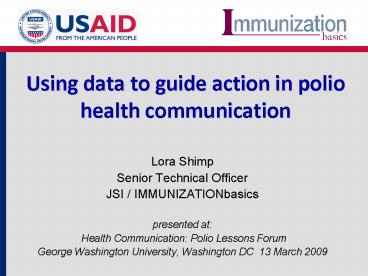Using data to guide action in polio health communication - PowerPoint PPT Presentation
1 / 24
Title:
Using data to guide action in polio health communication
Description:
Health Communication: Polio Lessons Forum ... immunization coverage for BCG, DPT, OPV and measles. DPT drop out rates. CMC & BMC tools ... – PowerPoint PPT presentation
Number of Views:23
Avg rating:3.0/5.0
Title: Using data to guide action in polio health communication
1
Using data to guide action in polio health
communication
- Lora Shimp
- Senior Technical Officer
- JSI / IMMUNIZATIONbasics
- presented at
- Health Communication Polio Lessons Forum
- George Washington University, Washington DC 13
March 2009
2
Communication in polio eradication has been an
evolutionary process
3
From communication theory
4
to planning and guidelines,
5
to practice (including monitoring)
6
Challenge linking communication with outcome
and impact
7
Remaining X houses CORE PVO mobilizer (CMC) vs
Non-CMC areas (Jan Mar 08), UP/India
Note In CORE area in March 08 round, total
688,333 children eligible. 452,432 vaccinated at
booth. Remaining X houses 32,093, with 692
resistant houses. (Source CORE Quarterly
Progress Report, Dec 07 Mar 08)
8
Planning, implementation and communication
- Assessing program status, communication needs and
channels - Planning together, based on analysis of
quantitative and qualitative data (e.g. coverage,
social mapping, surveillance) - Implementation - with prioritization of needs,
activities and focus areas - Periodic review of implementation, revising
planning, TAGs
9
Country examples of data use
- Communication indicators and data use in polio
eradication - India
- Nigeria
- DR Congo
10
Social Mobilization Network (SM Net) in India
- Planning based on underserved/high risk area
strategy and epidemiological and program data,
enables mid-stream changes and detailed
micro-plans. - Underserved areas and key NGO and community
partners identified, specific households/children
tracked, causes of resistance identified. - Catchment area resource and child mapping, house
to house missed child tracking (with detailed
newborn, routine immunization, and pregnant women
registers).
11
Data tracking - some key indicators in India/SM
Net
- SIA indicators
- booth coverage per round
- remaining X houses (and categorization)
- percentage of X houses converted to P houses
during the A team and B team activities - Routine immunization indicators
- newborn tracking
- children receiving zero dose of OPV
- immunization coverage for BCG, DPT, OPV and
measles - DPT drop out rates
12
Percentage booth coverage in CORE CMC vs non-CMC
areas (July Sept 07 Jan Mar 08 rounds)
13
How to link data with impact?
Source Muzaffarnagar district Fact Sheet, Sept
2006 (CORE)
14
Further use of data
15
Northern Nigeria polio endemic area
MISSED CHILDREN
NON-COMPLIANT HOUSEHOLDS
Source Tally and Monitoring data, 2008
16
Northern Nigeria Immunization Plus Day
information on percentage of missed children
during rounds
16
Source IPDs Tally Sheet Data
17
Reasons for IPD non-compliance in 4 highest risk
states (May-Aug 2008)
Next step include analysis of what is in the
others category
17
17
17
Jigawa, Kano, Katsina and Zamfara
18
DRC evolution of WPV and high risk provinces
WPV cases and route (Jan Sept 2007)
19
Polio SIA coverage in DRC by month, 2008
Mai
Juin
Septembre
Pop cible 6.836.972 Vaccinés 7.130.681 Nb de
ZS 263
Pop cible 7.264.921 Vaccinés 7.941.949 Nb de
ZS 287
Pop cible 3.821.215 Vaccinés 4.145.997 Nb de
ZS 174
20
Base indicators being used in DRC data from
November 2008
- 63 of Health Zones (HZ) have a communication
plan based on social and coverage data (polio) - 47 of HZs have a trained and functional
communication team/mobilizer - 78 of HZs have a map of special populations
- 60 of HZs have a map that shows resistant areas
and their relative size - of HZs with a communication budget that is
financed and dispursed data not available - 80 of parents are informed on the campaign dates
- 75 of parents know the illness for which their
child is being vaccinated - 90 of special groups reached by a mobilizer had
their children vaccinated
21
Where are the remaining pockets of unimmunized or
under-immunized?
22
Main communication indicators in 2008
- reduction in missed children
- reduction in non-compliant households
- Sources of information
- Knowledge of campaign
- Trend analysis!
22
23
How to link data with impact? Reference earlier
slide
Source Muzaffarnagar district Fact Sheet, Sept
2006 (CORE)
24
Key program needs for communication
- Linkages communication experts to use EPI data
and EPI includes communication indicators in M
E - Have standardized indicators for immunization
communication to help guide countries and
programs - Involve EPI and child health technical people in
communication monitoring and supervision - Use qualitative and quantitative data effectively
and efficiently and demonstrate communication
impact































